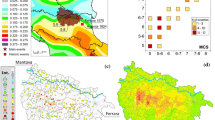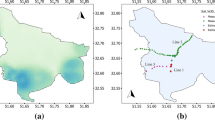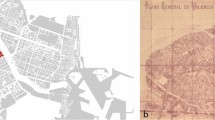Abstract
The main purpose of this study is to obtain the damage scenario for residential buildings in the occurrence of a destructive earthquake (M = 7+) in the city area of Catania, Eastern Sicily, and to illustrate the comparative performance of two alternative methods used for this purpose. The methods are representative of two different approaches to estimating the seismic vulnerability of structures, i.e., an empirical approach based on statistical score assignments (widely used in Italy and other countries) and a more recent, mechanical approach that uses displacement limit states associated with well-defined thresholds of structural damage. A special concern for seismic vulnerability in Catania is caused by the fact that earthquake design norms were enforced in its municipal area only since 1981. We emphasise some typical problems encountered in earthquake scenario work, such as the difficulty of assembling a reliable building inventory, and the uncertainties inherent in the vulnerability assessments through different probabilistic assumptions. Different criteria for the representation of damage are applied and discussed. It is shown that the main scenarios obtained by the two methods are in reasonable agreement, provided a suitable percentile level for damage is chosen in the statistical score assignment approach.
Similar content being viewed by others
References
Abrams, D.P., 1997, New American practices for seismic rehabilitation of masonry buildings, Proc. US-Italian Workshop on Seismic Evaluation and Retrofit, Report NCEER-97-0003, Buffalo, NY, pp. 143–156.
Ambraseys, N.N., 1995, The prediction of earthquake peak ground acceleration in Europe, Earthquake Engng. Structural Dynamics 24, 467–490.
Angeletti, P., Bellina, A., Guagenti, E., Moretti, A., Petrini, V., 1988, Comparison between vulnerability assessment and damage index, Proc. 9th World Conf. on Earthq. Engng., Tokyo-Kyoto, pp. 181–186.
ATC-21, 1988, Rapid visual screening of buildings for potential seismic hazards: a handbook, Applied Technology Council, Redwood City, California.
Azzaro, R., Barbano, M.S, Moroni, A., Mucciarelli, M., Stucchi, M., 1999, The seismic history of Catania, J. Seismology, this issue.
Baratta, M., 1910, The Calabro-Messinese Earthquake Catastrophe (December 28, 1908), 2 vols., Rome (in Italian).
Benedetti, D., Petrini, V., 1984, On seismic vulnerability of masonry buildings: proposal of an evaluation procedure, L'Industria delle Costruzioni 18, 66–78 (in Italian).
Bommer, J., Elnashai, A., Chlimintzas, G., Lee, D., 1998, Review and development of response spectra for displacement-based seismic design, ESEE Research Report 98-3, Civ. Engng. Dept., Imperial College, London, March.
Borzi, B., Elnashai, A., Faccioli, E., Calvi, G.M., Bommer, J., 1998, Inelastic spectra and ductility-damping relationships for displacement-based seismic design, ESEE Research Report 98-4, Civ. Engng. Dept., Imperial College, London, May.
Calvi, G.M., 1999, A displacement-based approach for vulnerability evaluation of classes of buildings, J Earthquake Engng. 4, accepted for publication.
CFT, 1995, Catalogue of Strong Earthquakes in Italy from 461 A. D. to 1980, Istituto Nazionale di Geofisica - SGA (Storia Geofisica Ambiente), Rome (in Italian).
Cherubini, A., 1997, The vulnerability survey of public, private, and monumental buildings in the regions of Southern Italy, Proc. 8th Italian National Conf. Earthq. Engng., Taormina, II, pp. 1329–1336 (in Italian).
CNR - GNDT, 1993, Seismic risk of public buildings, Vol. 1, Methodological aspects Research Report, Rome (in italian).
Colonna, E., Molina, C., Petrini, V., 1994, Criteria for evaluating the seismic vulnerability of buildings on the national territory, Ingegneria Sismica XI(1), 16–24 (in Italian).
Costley, A.C., Abrams, D.P., 1995, Dynamic response of URM buildings with flexible diaphragms, Structural Res. Series Report No. 605, University of Illinois at Urbana-Champaign, U.S.A.
Dato, G., 1983, The City of Catania. Form and Structure, 1693-1833, Rome (in italian).
D'Ayala, D., Spence, R., Oliveira, C., Pomonis, A., 1997, Earthquake loss estimation for Europe's historical town centres, Earthquake Spectra 13(4), 773–793.
GNDT, 1998a, Model for the vulnerability evaluation of masonry buildings in the historic centre of Catania based on the LSU rapid screening data, Technical document by theWorking Group Vulnerabilty of Catania, August (in Italian).
GNDT, 1998b, Model for the vulnerability evaluation of reinforced concrete buildings in the historic center of Catania based on the LSU rapid screening data, Technical document by the Working Group Vulnerabilty of Catania, August (in Italian).
Guagenti, E., Petrini, V., 1989, The case of old buildings: towards a damage-intensity relationship, Proc. 4th Italian National Conf. on Earthq. Engng., Milano, I, pp. 145–153 (in Italian).
Kircher, C. A., Nassar, A., Kustu, O. and Holmes, W. T., 1997, Development of buiding damage functions for earthquake loss estimation, Earthquake Spectra 13(4), 663–682.
Magenes, G. and Calvi, G.M., 1997, In-plane seismic response of brick masonry walls, Earthquake Engineering and Structural Dynamics, 26, 1091–112.
McGuire, R., 1995, Scenario earthquakes for loss studies based on risk analysis, Proc. 5th Intern. Conf. on Seismic Zonation, Nice, France, Oct. 17-19, II, pp. 1325–1333.
Pessina, V., 1998, Empirical prediction of the ground shaking scenario for the Catania area, J. Seismology, this issue.
Petrini, V., 1999, Evaluation of risk levels. In: Petrini, V. (ed.), Seismic hazard and first evaluation of risk in Tuscany, CNR - Regione Toscana Technical Report, Milano, Italy (in Italian).
Priolo, E., 1999, 2–D spectral element simulations of destructive ground shaking in Catania (Italy), J. Seismology, this issue.
Sirovich, L. and Pettenati, F., 1999, Seismotectonic outline of South-Easten Sicily: an evaluation of available options for the earthquake fault rupture scenario, J. Seismology, this issue.
Whitman, R.V., Anagnos, T., Kircher, C.A., Lagorio, H.J., Lawson, R.S., Schneider, P., 1997, Development of a national earthquake loss estimation methodology, Earthquake Spectra, 13(4), 643–661.
Zollo, A., Emolo, A., Herrero, H., Improta, L., 1999, Strong ground motion modelling in the Catania area associated to the Ibleo-Maltese fault system, J. Seismology, this issue.
Author information
Authors and Affiliations
Rights and permissions
About this article
Cite this article
Faccioli, E., Pessina, V., Calvi, G. et al. A study on damage scenarios for residential buildings in Catania city. Journal of Seismology 3, 327–343 (1999). https://doi.org/10.1023/A:1009856129016
Issue Date:
DOI: https://doi.org/10.1023/A:1009856129016




